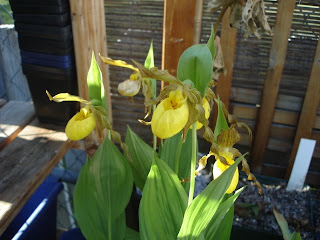
The first pic is of one of my Paph micranthums, in sheath. I have 2 mature plants and three seedlings. This will be the first to flower. Probably the most exciting thing going on right now. If you haven't yet seen a Paph micranthum flower, seek one out!
The second depicts Paph Satin Smoke (micranthum x primulinum, on the left) and Paph malipoense x jackii (on the right), in spike. The former is a gorgeous multifloral with big smoky-pink blooms, while the latter is a very large-flowered Parvi primary with fragrant green blossoms.
The third portrays Paph ang-thong (also known as Paph godefroyae var ang-thong, Paph niveum var ang-thong and Paph x ang-thong), in low spike. This will be an adorable little white flower with maroon speckles.
The fourth displays Paph Winston Churchill 'Indomitable' FCC/AOS x gratrixianum, a complex hybrid which I last posted on last summer when it first bloomed. It is in sheath.
Finally the last two photos are the first I have taken of my carnivorous plant terrarium, my first attempt at growing these plants that seems to be successful (the last couple times I tried I failed eventually). The plants are growing very vigorously and appear to be very healthy. A closeup of a Nepenthes viking pitcher through the glass is the subject of the fifth photo, while the last gives a view of the entire setup from the outside. I will explain this setup some other time. For now, can you identify all the plants in the last photo? Visible are Nepenthes viking (tropical pitcher plant), Sarracenia pstittacina (parrot pitcher plant), Pinguicula moranensis (Mexican butterwort), Cephalotus follicularis (Albany pitcher plant, barely visible), Dionaea muscipula 'B-52' (giant Venus flytrap), and Dionaea muscipula (typical Venus flytrap). There is also an orchid residing in this tank, Leptotes unicolor, a Brazilian miniature which looks like it may bloom soon. There is one more plant in here which is not visible in the photos, Drosera capensis (cape sundew).


 This gorgeous hybrid owes most of its striking charisma to the Paph micranthum parent, which lends its large pouch with contrasting smaller tepals having pink-red stripes to the picture. The primulinum parent adds a slightly altered pouch and tepal shape (more slender), more subdued coloring (the pouch is ivory and the tepals a soft misty pink), a multifloral habit (2-3 sequentially opening flowers per stem), and ease of culture, which is a major drawback for micranthum. So what you get is a flower very similar to micranthum, but in greater numbers and appearing much easier than micranthum! I don't believe any of the hybrids made with micranthum are any better-looking than the species (not even Magic Lantern), but this is an amazing plant well worth seeking out. I have taken three photos of the same flower at different angles so one can fully appreciate the three-dimensional character of the bloom (which is a feature of any slipper orchid but especially with this one).
This gorgeous hybrid owes most of its striking charisma to the Paph micranthum parent, which lends its large pouch with contrasting smaller tepals having pink-red stripes to the picture. The primulinum parent adds a slightly altered pouch and tepal shape (more slender), more subdued coloring (the pouch is ivory and the tepals a soft misty pink), a multifloral habit (2-3 sequentially opening flowers per stem), and ease of culture, which is a major drawback for micranthum. So what you get is a flower very similar to micranthum, but in greater numbers and appearing much easier than micranthum! I don't believe any of the hybrids made with micranthum are any better-looking than the species (not even Magic Lantern), but this is an amazing plant well worth seeking out. I have taken three photos of the same flower at different angles so one can fully appreciate the three-dimensional character of the bloom (which is a feature of any slipper orchid but especially with this one).

















































